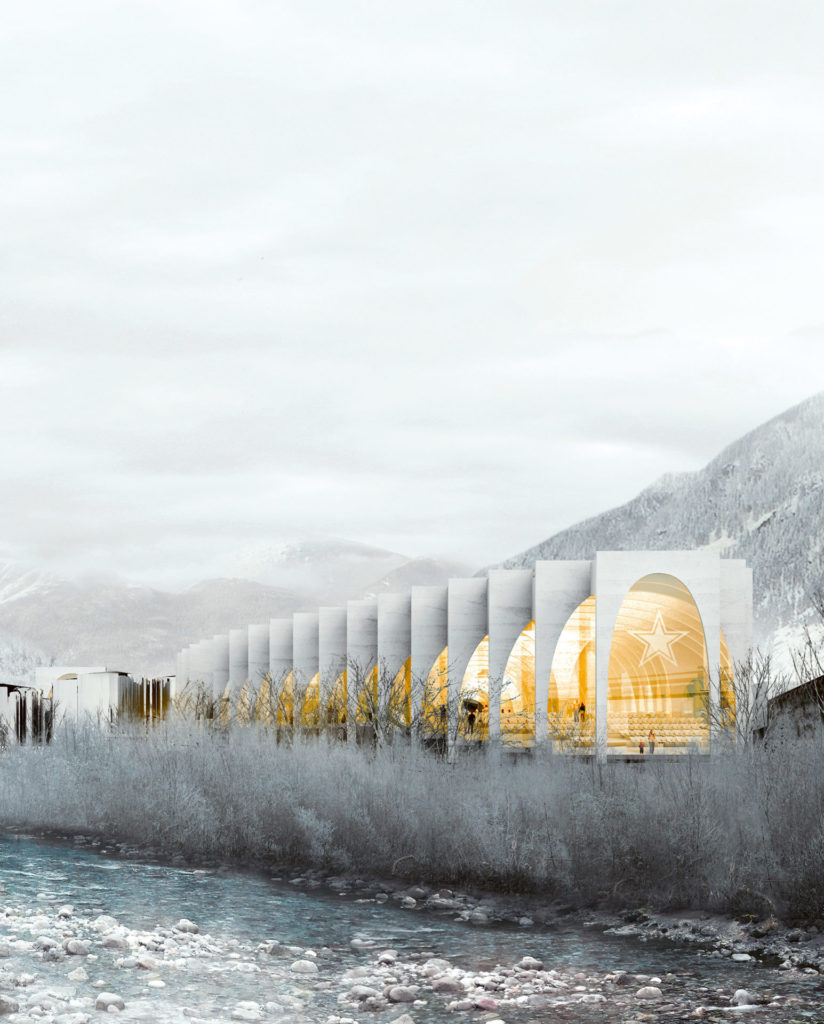Visitors to Italy have plenty of pilgrimages to choose from. You can tread the cobblestones of Florence to see Botticelli’s “Birth of Venus” at the Uffizi galleries. You can charter a gondola to peep the underside of Venice’s famous Rialto Bridge. And soon, you’ll be able to make the trek to mountainous Brembana Valley in northern Italy to seek the source of San Pellegrino, one of the world’s best loved mineral waters. It’s a trip that hydration fanatic Leonardo Da Vinci made in 1509, inspiring a treatise on the subject of water. In those days, San Pellegrino was a far humbler alpine destination.
The San Pellegrino Flagship Factory
Once the San Pellegrino Flagship Factory is completed in 2022 or 2023, pilgrims will find a state-of-the art, $95 million headquarters. Serving as a bottling plant, visitors’ center, and monument to the green-bottled brand, the Flagship is the effervescent brainchild of Danish architecture firm Bjarke Ingels Group (BIG), selected in an international design competition for the job.

As one might expect at a cathedral to mineral water, a sense of geology is at the heart of the experience. The building’s storytelling is meant to evoke the thirty-year journey of San Pellegrino’s flagship product from the summit of the mountain to its source. And in the building’s courtyard, visitors can see a core sample of the mountain’s stratified rock that gives the water its mineral quality. Aesthetically, the complex is inspired by classical Italian forms. Visitors are welcomed by an open piazza of undulating brick and a wall of minimal stone archways. These simple arches dominate the complex, acting as porticos, bridges, and sculptures throughout. The overall effect is to distill a history of architecture into a single expression as timeless as the water that’s bottled there.
However, there’s clearly another inspiration for the building’s sensibility: San Pellegrino’s brand itself. Inviting but austere, aspirational but democratic, the project feels just as informed by a high-level creative brief as much as it does by architectural drawings.


At some point—long ago—the idea of a “brand” was straightforward. Designed to help differentiate a company’s product or service from the competition, a brand might include a company’s name, logo, and color palette. Today, however, the concept of “brand” has grown to encompass myriad associated concepts, from sponsored content creation to meticulously planned experiences to apparel partnerships. The idea is that consumers will form a positive collective impression from these disparate touch points and, ideally, buy more of your company’s fizzy water instead of someone else’s. Unsurprisingly, brand thinking has also entered the architectural realm, guiding decisions at the highest levels.
The Plus
Branded architecture also drives another of BIG’s high-profile projects: The Plus. Designed for Norwegian outdoor furniture brand Vestre, The Plus bills itself as the world’s most environmentally friendly furniture factory. Acting as a manufacturing plant plus a visitors’ center, it’s not hard to glean the reason for the all-in-one building’s name. It’s also shaped like a giant plus sign. In the world of branding, subtlety isn’t as important as clarity and consistency.

Vibrant and whimsical, the facility is a LEGO–futurist marvel that practically shouts Vestre’s five-point brand manifesto at every turn. Brightly color-coded to elucidate the furniture-building process, the interiors resemble something between a giant subway map and a board game for toddlers. Curious visitors can follow furniture’s progress across the four wings: Wood Factory, Color Factory, Assembly, and Warehouse.
Nestled in a forest, The Plus is surrounded tightly by trees, while the building’s circular-open-air hub brings the outside in with a playful spiral staircase. Snaking paths surround the facility, encouraging visitors to explore, play, and even camp out near the factory. For a company that builds bike racks, picnic tables, and planters for public use, it’s only fitting that the headquarters feels inviting, encouraging, and filled with wonder for nature.

In a sense, branded headquarters are nothing new. Every corporate visitors center ever built has made some attempt to turn curious fans into lifelong loyalists. However, what may be new is the BIG’s ability to elegantly translate a brand’s intangible qualities into designed space. If more brands boasted a headquarters as compelling as San Pellegrino or Vestre, it’s entirely plausible that we’d start to see an emergence of another kind of tourism: the brand pilgrimage. Already common for breweries, distilleries, and vineyards, one can easily imagine eager tourists planning their vacations around seeing the homes of the brands they love best.




